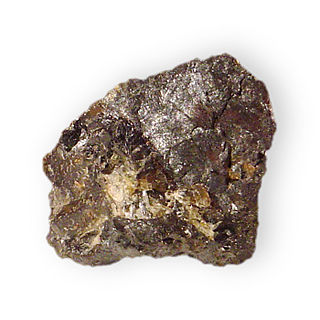
Zinkenite is a steel-gray metallic sulfosalt mineral composed of lead antimony sulfide Pb9Sb22S42. Zinkenite occurs as acicular needle-like crystals.

Diadochite is a phospho-sulfate mineral. It is a secondary mineral formed by the weathering and hydration of other minerals. Its formula is Fe2(PO4)(SO4)OH·5H2O. Well crystallized forms are referred to as destinezite, which has been given official recognition by the International Mineralogical Association with diadochite being the poorly formed to amorphous variety.

Tusionite is a rare colorless to transparent to translucent yellow brown trigonal borate mineral with chemical formula: MnSn(BO3)2. The mineral is composed of 18.86% manganese, 40.76% tin, 7.42% boron, and 32.96% oxygen. It is a late stage hydrothermal mineral and occurs rarely in granite pegmatites in miarolitic cavities.
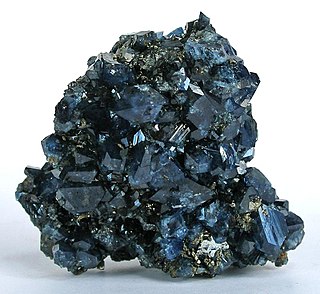
Scorodite is a common hydrated iron arsenate mineral, with the chemical formula FeAsO4·2H2O. It is found in hydrothermal deposits and as a secondary mineral in gossans worldwide. Scorodite weathers to limonite.

Warwickite is an iron magnesium titanium borate mineral with the chemical formula (MgFe)3Ti(O, BO3)2orMg(Ti,Fe3+, Al)(BO3)O. It occurs as brown to black prismatic orthorhombic crystals which are vitreous and transparent. It has a Mohs hardness of 3 to 4 and a specific gravity of 3.36.

Cerite is a complex silicate mineral group containing cerium, formula (Ce,La,Ca)
9(Mg,Fe3+
)(SiO
4)
6(SiO
3OH)(OH)
3. The cerium and lanthanum content varies with the Ce rich species and the La rich species. Analysis of a sample from the Mountain Pass carbonatite gave 35.05% Ce
2O
3 and 30.04% La
2O
3.

Franckeite, chemical formula Pb5Sn3Sb2S14, belongs to a family of complex sulfide minerals. Franckeite is a sulfosalt. It is closely related to cylindrite.

Empressite is a mineral form of silver telluride, AgTe. It is a rare, grey, orthorhombic mineral with which can form compact masses, rarely as bipyramidal crystals.

Clausthalite is a lead selenide mineral, PbSe. It forms a solid solution series with galena PbS.

Agrellite (NaCa2Si4O10F) is a rare triclinic inosilicate mineral with four-periodic single chains of silica tetrahedra.
Alloclasite is a sulfosalt mineral. It is a member of the arsenopyrite group. Alloclasite crystallizes in the monoclinic system and typically forms as columnar to radiating acicular prismatic clusters. It is an opaque steel-gray to silver-white, with a metallic luster and a black streak. It is brittle with perfect cleavage, a Mohs hardness of 5 and a specific gravity of 5.91–5.95.

Thomasclarkite-(Y) is a rare mineral which was known as UK-93 until 1997, when it was renamed in honour of Thomas H. Clark (1893–1996), McGill University professor. The mineral is one of many rare-earth element minerals from Mont Saint-Hilaire. The only reported occurrence is in an alkalic pegmatite dike in an intrusive gabbro-nepheline syenite.
Rhomboclase is an acidic iron sulfate mineral with a formula reported as H5Fe3+O2(SO4)2·2(H2O) or HFe(SO4)2·4(H2O). It crystallizes in the orthorhombic system and typically occurs as tabular crystals with a rhombic outline. It occurs as transparent colorless, blue, green, yellow or grey crystals with a vitreous to pearly luster.
Brownleeite is a silicide mineral with chemical formula MnSi. It was discovered by researchers of the Johnson Space Center in Houston while analyzing the Pi Puppid particle shower of the comet 26P/Grigg-Skjellerup. The only other known natural manganese silicide is mavlyanovite, Mn5Si3.
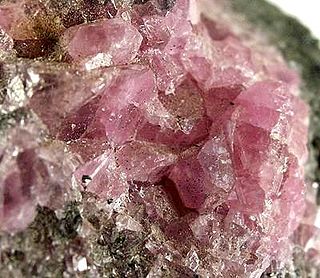
Hodgkinsonite is a rare zinc manganese silicate mineral Zn2MnSiO4(OH)2. It crystallizes in the monoclinic system and typically forms radiating to acicular prismatic crystals with variable color from pink, yellow-red to deep red. Hodgkinsonite was discovered in 1913 by H. H. Hodgkinson, for whom it is named in Franklin, New Jersey, and it is only found in that area.

Schröckingerite is a radioactive yellow uranium-containing carbonate mineral, hydrated sodium calcium uranyl sulfate carbonate fluoride. Schröckingerite crystallizes in the orthorhombic system, occurring as globular clusters, and fluoresces yellow-green under ultraviolet light.
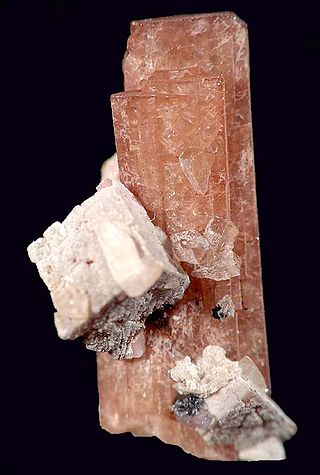
Ancylite is a group of hydrous strontium carbonate minerals containing cerium, lanthanum and minor amounts of other rare-earth elements. The chemical formula is Sr(Ce,La)(CO3)2(OH)·H2O with ancylite-Ce enriched in cerium and ancylite-La in lanthanum.
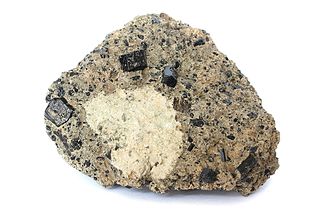
Kaersutite is a dark brown to black double chain calcic titanium bearing amphibole mineral with formula: NaCa2(Mg3Ti4+Al)(Si6Al2)O22(O)2.
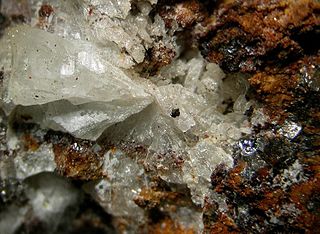
Fluellite is a mineral with the chemical formula Al2(PO4)F2(OH)•7H2O. The name is from its chemical composition, being a fluate of alumine (French).

Corkite is a phosphate mineral in the beudantite subgroup of the alunite group. Corkite is the phosphate analogue of beudantite and with it, a complete solid solution range exists. Corkite will also form a solid solution with kintoreite.

















